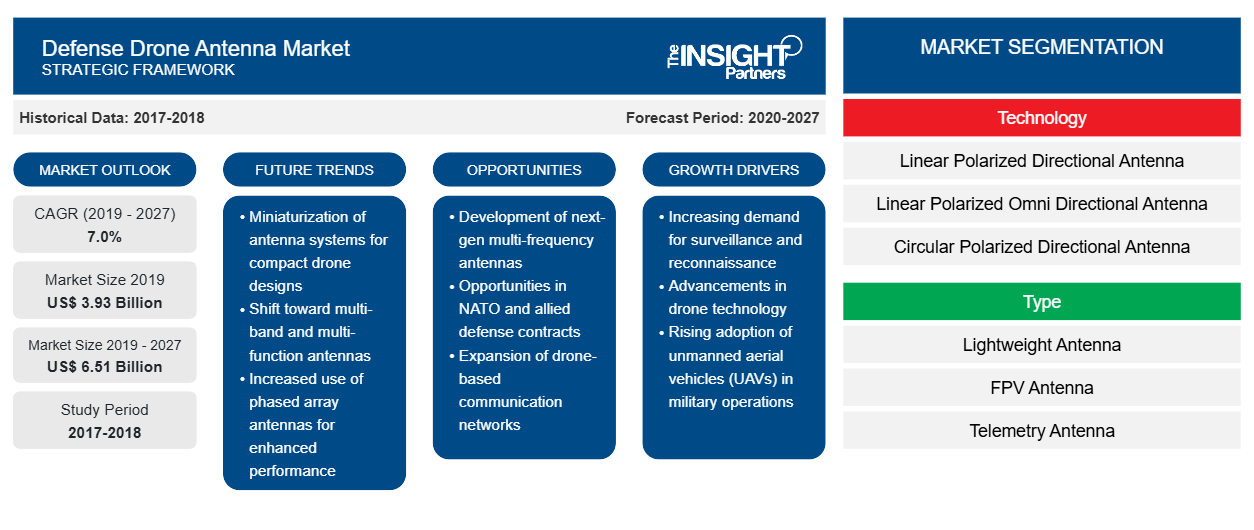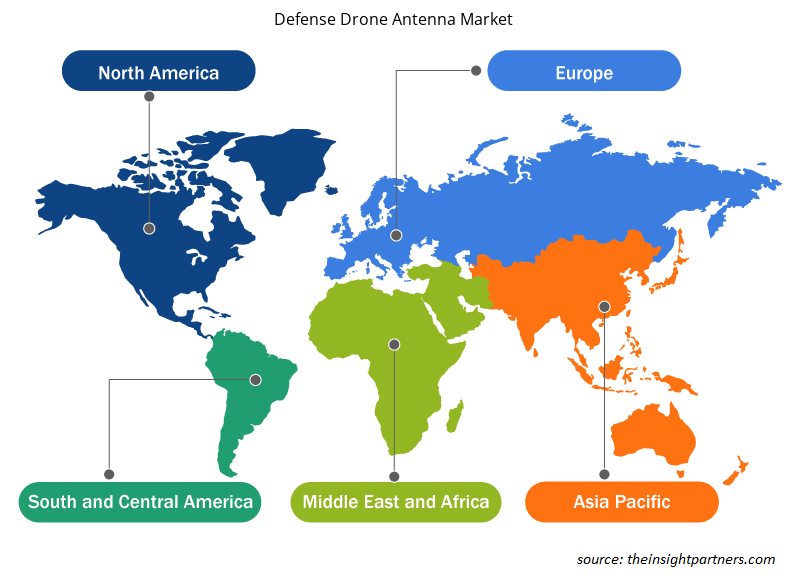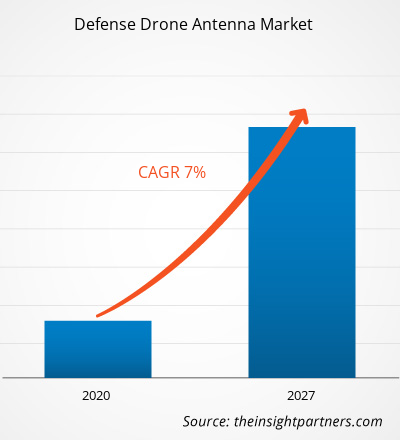In terms of revenue, the global defense drone antenna market was valued at US$ 3,925.61 million in 2019 and is projected to reach US$ 6,505.28 million by 2027; it is expected to grow at a CAGR of 7.0% during the forecast period from 2020 to 2027.
The defense drone antenna market is broadly segmented into five major regions—North America, Europe, APAC, MEA, and SAM. North America dominates the market for military UAVs. Thus the demand for defense drone antennas from the region is high. The players and government in the US are significantly investing in R&D related to military UAVs. Apart from this, collaborations amongst industry giants, together with surging investments in developing technologically advanced UAVs to support many military applications, would accelerate the demand for military UAVs in the US.
Customize This Report To Suit Your Requirement
You will get customization on any report - free of charge - including parts of this report, or country-level analysis, Excel Data pack, as well as avail great offers and discounts for start-ups & universities
Defense Drone Antenna Market: Strategic Insights

- Get Top Key Market Trends of this report.This FREE sample will include data analysis, ranging from market trends to estimates and forecasts.
You will get customization on any report - free of charge - including parts of this report, or country-level analysis, Excel Data pack, as well as avail great offers and discounts for start-ups & universities
Defense Drone Antenna Market: Strategic Insights

- Get Top Key Market Trends of this report.This FREE sample will include data analysis, ranging from market trends to estimates and forecasts.
Market Insights–Defense Drone Antenna Market
Mounting Interest in Circular Omni-Directional Antennas
Military forces utilize unmanned technologies for purposes such as surveillance, communications, navigation, and signal intelligence (SIGINT). The military forces are continuously seeking advanced technologies with an objective to enhance the capabilities of the unmanned vehicles. The linear polarized omnidirectional antennas are among the preferred antenna technologies. However, the preference for circular polarized omnidirectional antennas is rising at an exponential rate. The modern-day military drones need to constantly move or maneuver to gather higher volumes of information; thus, sometimes they need to adopt acrobatic flying. The circular antennas are smaller, which offer added advantage for easy maneuverability. In addition to smaller antenna size, the ability to transmit the collected data at 360° is gathering interest of defense forces as well as the defense drone manufacturers. Moreover, the military forces demand exceptional quality of captured data and images among the military forces, and these antennas facilitate the transmission of high-quality images during the drone flight at close proximity of the target. Such benefits of circular omnidirectional antennas are contributing to the defense drone antenna market growth.
Technology Segment Insights
Based on technology, the linear polarized omnidirectional antenna segment dominated the global defense drone antenna market in 2019. The linear antennas project a wave along a singular plane, horizontal or vertical. This kind of polarization facilitates more energy to be transmitted, as the wave simply moves in one direction.
Type Segment Insights
Based on type, the lightweight antenna segment dominated the global defense drone antenna market in 2019. Smaller and lighter weight UAVs are significantly being utilized for more complex intelligence and communications applications. In order to increase the loitering competence and persistence of these vehicles, there is a growing requirement of lighter weight, more aerodynamic antenna.
Frequency Segment Insights
Based on frequency, the ultra-high frequency segment dominated the global defense drone antenna market in 2019. The ultra-high frequency (UHF) antennas operate with the frequency range of above 300Mhz. In the current scenario, UHF is the most commonly utilized frequency band.
Application Segment Insights
Based on industry, the communication segment dominated the global defense drone antenna market in 2019. The UAV manufacturers are continuously emphasizing, integrating state of the art communication system with an objective to facilitate the military personnel at the Base Station to communicate with the UAV. In order to integrate the best communication systems, the need for communication antenna is of supreme significance. Attributing to the fact that the importance of communication antenna on a UAV, the demand for the antenna is anticipated to remain high throughout the forecast period.
The market players focus on new product innovations and developments by integrating advanced technologies and features in their products to compete with the competitors.
- In 2020, PPM announced the opening of 40 new offices in the UK to expand its engineering and design, sales and marketing, customer service, and accounts work.
- In 2020, Southwest Antennas introduced two new omnidirectional antennas for use in UHF and ISM band applications. These are ideal for tactical radio systems, handheld video receivers, MIMO & MANET radio systems, unmanned robotics platforms, and other applications. The new antennas either come in Ultra-Flex sealed spring base or flexible gooseneck base.
Defense Drone Antenna Market Regional Insights
The regional trends and factors influencing the Defense Drone Antenna Market throughout the forecast period have been thoroughly explained by the analysts at Insight Partners. This section also discusses Defense Drone Antenna Market segments and geography across North America, Europe, Asia Pacific, Middle East and Africa, and South and Central America.

- Get the Regional Specific Data for Defense Drone Antenna Market
Defense Drone Antenna Market Report Scope
| Report Attribute | Details |
|---|---|
| Market size in 2019 | US$ 3.93 Billion |
| Market Size by 2027 | US$ 6.51 Billion |
| Global CAGR (2019 - 2027) | 7.0% |
| Historical Data | 2017-2018 |
| Forecast period | 2020-2027 |
| Segments Covered |
By Technology
|
| Regions and Countries Covered | North America
|
| Market leaders and key company profiles |
Defense Drone Antenna Market Players Density: Understanding Its Impact on Business Dynamics
The Defense Drone Antenna Market is growing rapidly, driven by increasing end-user demand due to factors such as evolving consumer preferences, technological advancements, and greater awareness of the product's benefits. As demand rises, businesses are expanding their offerings, innovating to meet consumer needs, and capitalizing on emerging trends, which further fuels market growth.
Market players density refers to the distribution of firms or companies operating within a particular market or industry. It indicates how many competitors (market players) are present in a given market space relative to its size or total market value.
Major Companies operating in the Defense Drone Antenna Market are:
- Alaris Holdings Ltd.
- Antcom Corporation
- Antenna Research Associates, Inc.
- Cobham Plc
- JEM Engineering
Disclaimer: The companies listed above are not ranked in any particular order.

- Get the Defense Drone Antenna Market top key players overview
The global defense drone antenna market has been segmented as follows:
Defense Drone Antenna Market – By Technology
- Linear Polarized Directional Antenna
- Linear Polarized Omni Directional Antenna
- Circular Polarized Directional Antenna
- Circular Polarized Omni Directional Antenna
Defense Drone Antenna Market – By Type
- Lightweight Antenna
- FPV Antenna
- Telemetry Antenna
- NLOS Antenna
- Others
Defense Drone Antenna Market – By Frequency
- High Frequency
- Very High Frequency
- Ultra-High Frequency
Defense Drone Antenna Market – By Application
- Surveillance
- Navigation
- Communication
- Telemetry
- Others
Defense Drone Antenna Market- By Region
- North America
- US
- Canada
- Mexico
- Europe
- France
- Germany
- Italy
- Spain
- Switzerland
- UK
- Rest of Europe
- Asia Pacific (APAC)
- China
- India
- South Korea
- Singapore
- Japan
- Australia
- Rest of APAC
- Middle East and Africa (MEA)
- South Africa
- Saudi Arabia
- UAE
- Rest of MEA
- South America (SAM)
- Brazil
- Rest of SAM
Defense Drone Antenna Market – Companies Profiles
- Alaris Holdings Ltd.
- Antcom Corporation
- Antenna Research Associates, Inc.
- Cobham Plc
- JEM Engineering
- MP Antenna, LTD
- PPM Systems
- Southwest Antennas, Inc.
- TE Connectivity
- Trimble Inc.
Frequently Asked Questions
Which technology led the defense drone antenna market?
The linear polarized omni directional antenna segment led the technology segment. The linear antennas project a wave along a singular plane, horizontal or vertical. This kind of polarization facilitates more energy to be transmitted, as the wave simply moves in one direction. However, penetration of obstacles is reduced pertaining to the difficulty a linear wave faces in navigating around an object that is present in its plane of propagation. On the other hand, omnidirectional antennas are best suitable for the radiation of a signal in all possible directions, but over a comparatively shorter range. The radiation pattern can be clearly captured in the omnidirectional antennas as being particularly well dispersed in all the directions covering the antenna apart from directly below and above the antenna. These antennas are mainly utilized with the video transmitter, as the antennas are well adapted to overcome unexpected changes in the direction and attitude of an aircraft’s flight.
Which region will lead the defense drone antenna market in 2027?
North America is expected to be the largest revenue generator in the defense drone antenna market compared to the other regions. The US Department of Defense (DoD) is anticipated to increase its UAV spending in the next few years to prepare the military for high-end fights against advanced rivals. There was an inclusion of the spending of US$ 3.7 billion on new unmanned systems technology in the president defense budget request for FY 2020. According to the dean of the Mitchell Institute for Aerospace Studies, the US military has enormous opportunities to use UAVs more commonly in various applications, including cargo aircraft and combat aircraft. The growing demand for drones for military application in North America is expected to drive the growth of defense drone antenna market.
Which factor is driving the defense drone antenna market?
A rapidly changing modern warfare has been urging governments of various countries to allocate higher amounts toward the respective military forces. The military budget allocation enables the military forces to procure advanced technologies and equipment from national or international manufacturers. On the same lines, solider and military vehicle modernization practices are also on rise in many countries. The procurement of drones or unmanned aerial vehicles (UAVs) is a major part of this modernization strategy. In addition, the defense ministries worldwide are investing substantial amounts in newer technologies, including contemporary UAVs or unmanned aircraft systems (UAS). Surge in orders for the drones or UAVs or UASs from the defense forces signifies a substantial demand for drone antennas, which is driving the defense drone antenna market.
- Historical Analysis (2 Years), Base Year, Forecast (7 Years) with CAGR
- PEST and SWOT Analysis
- Market Size Value / Volume - Global, Regional, Country
- Industry and Competitive Landscape
- Excel Dataset
- Aircraft MRO Market
- Helicopter Hoists Winches and Hooks Market
- Fixed-Base Operator Market
- Aerospace Fasteners Market
- Aerospace Stainless Steel And Superalloy Fasteners Market
- Aircraft Floor Panel Market
- Military Optronics Surveillance and Sighting Systems Market
- Smoke Grenade Market
- Airport Runway FOD Detection Systems Market
- Artillery Systems Market
Testimonials
I wish to appreciate your support and the professionalism you displayed in the course of attending to my request for information regarding to infectious disease IVD market in Nigeria. I appreciate your patience, your guidance, and the fact that you were willing to offer a discount, which eventually made it possible for us to close a deal. I look forward to engaging The Insight Partners in the future, all thanks to the impression you have created in me as a result of this first encounter.
DR CHIJIOKE ONYIA, MANAGING DIRECTOR, PineCrest Healthcare Ltd.The Insight Partners delivered insightful, well-structured market research with strong domain expertise. Their team was professional and responsive throughout. The user-friendly website made accessing industry reports seamless. We highly recommend them for reliable, high-quality research services
Yukihiko Adachi CEO, Deep Blue, LLC.Reason to Buy
- Informed Decision-Making
- Understanding Market Dynamics
- Competitive Analysis
- Customer Insights
- Market Forecasts
- Risk Mitigation
- Strategic Planning
- Investment Justification
- Identifying Emerging Markets
- Enhancing Marketing Strategies
- Boosting Operational Efficiency
- Tracking Industry Innovations
- Aligning with Regulatory Trends
Yes! We provide a free sample of the report, which includes Report Scope (Table of Contents), report structure, and selected insights to help you assess the value of the full report. Please click on the "Download Sample" button or contact us to receive your copy.
Absolutely — analyst assistance is part of the package. You can connect with our analyst post-purchase to clarify report insights, methodology or discuss how the findings apply to your business needs.
Once your order is successfully placed, you will receive a confirmation email along with your invoice.
• For published reports: You’ll receive access to the report within 4–6 working hours via a secured email sent to your email.
• For upcoming reports: Your order will be recorded as a pre-booking. Our team will share the estimated release date and keep you informed of any updates. As soon as the report is published, it will be delivered to your registered email.
We offer customization options to align the report with your specific objectives. Whether you need deeper insights into a particular region, industry segment, competitor analysis, or data cut, our research team can tailor the report accordingly. Please share your requirements with us, and we’ll be happy to provide a customized proposal or scope.
The report is available in either PDF format or as an Excel dataset, depending on the license you choose.
The PDF version provides the full analysis and visuals in a ready-to-read format. The Excel dataset includes all underlying data tables for easy manipulation and further analysis.
Please review the license options at checkout or contact us to confirm which formats are included with your purchase.
Our payment process is fully secure and PCI-DSS compliant.
We use trusted and encrypted payment gateways to ensure that all transactions are protected with industry-standard SSL encryption. Your payment details are never stored on our servers and are handled securely by certified third-party processors.
You can make your purchase with confidence, knowing your personal and financial information is safe with us.
Yes, we do offer special pricing for bulk purchases.
If you're interested in purchasing multiple reports, we’re happy to provide a customized bundle offer or volume-based discount tailored to your needs. Please contact our sales team with the list of reports you’re considering, and we’ll share a personalized quote.
Yes, absolutely.
Our team is available to help you make an informed decision. Whether you have questions about the report’s scope, methodology, customization options, or which license suits you best, we’re here to assist. Please reach out to us at sales@theinsightpartners.com, and one of our representatives will get in touch promptly.
Yes, a billing invoice will be automatically generated and sent to your registered email upon successful completion of your purchase.
If you need the invoice in a specific format or require additional details (such as company name, GST, or VAT information), feel free to contact us, and we’ll be happy to assist.
Yes, certainly.
If you encounter any difficulties accessing or receiving your report, our support team is ready to assist you. Simply reach out to us via email or live chat with your order information, and we’ll ensure the issue is resolved quickly so you can access your report without interruption.















The List of Companies - Defense Drone Antenna Market
- Alaris Holdings Ltd.
- Antcom Corporation
- Antenna Research Associates, Inc.
- Cobham Plc
- JEM Engineering
- MP Antenna, LTD
- PPM Systems
- Southwest Antennas, Inc.
- TE Connectivity
- Trimble Inc.






 Get Free Sample For
Get Free Sample For